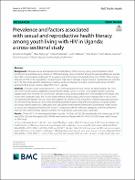| dc.contributor.author | Mugabi, Benedicto | |
| dc.contributor.author | Nanyingi, Miisa | |
| dc.contributor.author | Kabanda, Richard | |
| dc.contributor.author | Ndibazza | |
| dc.contributor.author | Ndibazza, Juliet | |
| dc.contributor.author | Elyanu, Peter | |
| dc.contributor.author | Asiimwe, John Baptist | |
| dc.contributor.author | Nazziwa, Gorret | |
| dc.contributor.author | Habaasa, Gilbert | |
| dc.contributor.author | Kekitiinwa, Adeodata | |
| dc.date.accessioned | 2024-04-03T13:57:26Z | |
| dc.date.available | 2024-04-03T13:57:26Z | |
| dc.date.issued | 2023-08-07 | |
| dc.identifier.issn | 1471-2458 | |
| dc.identifier.uri | http://hdl.handle.net/20.500.12280/3099 | |
| dc.description.abstract | Adequate sexual and reproductive health literacy (SRHL) among young people has been linked
to informed sexual behaviours. Studies on SRHL have largely been conducted among the general adolescent population. Little is known about youth aged 15-24 years living with human immunodefciency virus (YLHIV). There is a possible lack of SRHL in this population, considering the high rate of teenage pregnancies and unprotected sex reported
by YLHIV. This study aimed to assess the prevalence and associated personal and environmental factors for SRHL
among YLHIV at a high-volume urban HIV Clinic in Uganda.
Through a cross-sectional survey, YLHIV receiving routine HIV care services at Baylor-Uganda HIV Clinic
were interviewed using an adapted European Health Literacy Survey (HLS-EU). Using simple random sampling,
eligible youth who received HIV care services between August and November 2019 were enrolled in the study. SRHL
scores were computed using the HLS-EU index method; and individuals whose scores ranged from 34 to 50 were
considered health literate. We used descriptive statistics to determine the prevalence. Potential associated personal
and environmental factors (p<0.05) were identifed by performing two-step inferential statistics, bivariate analysis
and binary logistic regression. Odds ratios were calculated to estimate the likelihood of youth being health literate
on sexual and reproductive health (SRH) issues in comparison with the reference categories, and 95% confdence
intervals were determined to establish whether the relationships were statistically signifcant.
Of the 267 YLHIV interviewed at Baylor-Uganda HIV Clinic, 167 (62.5%) were female with a mean age of 18.9
years (SD± 2.8), and the majority (242; 90.6%) were vertically infected with HIV. Only 52 (19.5%) were health literate
on SRH issues.
At the multivariate level, YLHIV who never had difculty accessing SRH information were 0.391 times less likely to be
health literate on SRH issues than their counterparts with challenges in accessing SRH information (Adjusted Odds
Ratio [AOR] = 0.391, 95% CI =0.178 to 0.860; p= 0.019). YLHIV who did not fnd it easy to access SRH care service points
were 2.929 times more likely to be literate in SRH than those who found it easy to access such services (Adjusted Odds
Ratio [AOR] = 2.929, 95% CI =1.241 to 6.917; p=0.014). Additionally, YLHIV who did not listen to radio health talks were 2.406 times more likely to be health literate on SRH issues than those who did (AOR = 2.406, 95% CI =1.133 to 5.112;
p=0.022).
SRHL is an unmet need among YLHIV; only 19.5% were health literate on SRH issues. This could complicate the achievement of the UNAIDS sustainable development goal (SDG) of an HIV/AIDS-free generation by 2030
because low health literacy (HL) skills can afect the efcacy of almost all HIV disease prevention and health promotion eforts. Inaccessible SRH care service points and not listening to radio health talks were positively associated
with SRHL, while having access to SRH information was negatively associated with SRHL. | en_US |
| dc.language.iso | en | en_US |
| dc.publisher | Springer Link | en_US |
| dc.relation.ispartofseries | BMC Public Health;(2023) 23:1497 | |
| dc.subject | Sexual and reproductive health | en_US |
| dc.subject | Sexual and reproductive health literacy | en_US |
| dc.subject | Youth | en_US |
| dc.subject | Human immunodefciency virus | en_US |
| dc.subject | Prevalence | en_US |
| dc.subject | Associated factors | en_US |
| dc.subject | Clinical centre of excellence | en_US |
| dc.title | Prevalence and factors associated with sexual and reproductive health literacy among youth living with HIV in Uganda: a cross-sectional study | en_US |
| dc.type | Article | en_US |


